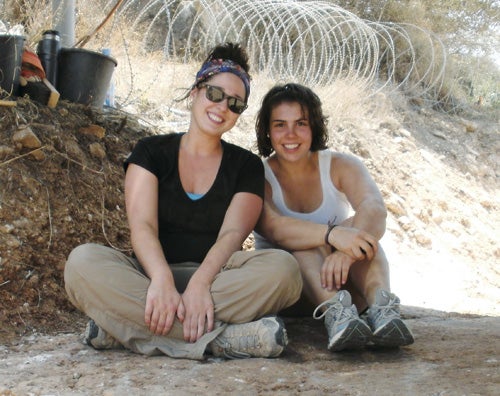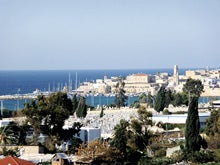Touching the Past in Israel

URI students combine land exploration with underwater archaeology.
Photos and footage from the 2011 trip.
“A shuttle picked us up every morning at 6:30 a.m. and dropped us off at a banana planation. A quick hike through the banana trees and we were at our site,” senior Abbie Casavant remembers. “It didn’t look like much at first—just a big, open, dusty construction site.”
Casavant, a senior majoring in history and anthropology and minoring in underwater archaeology, was near Haifa, Israel, in July 2011, one of 12 undergraduates to participate in the pilot year of URI’s Israel Coast Exploration Project, an 8-credit summer program coordinated by William Krieger, assistant professor of philosophy, and Bridget Buxton, assistant professor of history.
The three-week long summer program is an innovative combination of underwater and on-land archaeology. Although only in its first year, it was the third largest international program at URI last summer.
 “Underwater digs and terrestrial digs are generally kept very separate,” explains Krieger. “We want to move the field forward in a way that is explicitly integrative and theoretically based.” Archaeologists usually train through field schools, but none of the schools in Israel have included underwater components. “This was a single project working on one question,” says Krieger. “We want to understand a coastal city in its entirety as it relates to the surrounding cities and the region as it was in antiquity. Much of this may currently be underwater. We want to get a full picture, instead of just a few separate snapshots.”
“Underwater digs and terrestrial digs are generally kept very separate,” explains Krieger. “We want to move the field forward in a way that is explicitly integrative and theoretically based.” Archaeologists usually train through field schools, but none of the schools in Israel have included underwater components. “This was a single project working on one question,” says Krieger. “We want to understand a coastal city in its entirety as it relates to the surrounding cities and the region as it was in antiquity. Much of this may currently be underwater. We want to get a full picture, instead of just a few separate snapshots.”
For its first year, the coordinators selected two nearby sites on the northern coast of Israel for the underwater and terrestrial components. Students could choose to focus on either the land or water component. “But everyone digs,” explains Krieger, “There are many things that an archeologist does that an underwater specialist doesn’t. We wanted everyone to have a full training.”
“We started digging at around 7:30 a.m. after setting up our tents and getting our tools out,” explains Casavant. Becky Wrightson, a senior art history major, explains that the shade tents were a neces-sity due to the high temperatures and humidity. “We would spend the next few hours digging with pick-axes and smaller shovels. We worked in groups in separate areas within the overall dig site,” she remembers. “We would systematically clear the dirt away, keeping the level of the square even. We would keep records of what we were doing and what we were finding. We made sure to take measurements and drawings of the site before and after digging every day. We also had buckets set up collecting pieces of pottery, glass, and whatever other artifacts we found.”
“Working all day in the heat was tough!” says Casavant. “At the end of the day, we were covered in dirt from head to toe—caked in our hair, ears, and noses.”
Meanwhile, every day the weather permitted, Buxton was heading into the water. “I ended up taking one student for our first year,” she explains, as students already have to be certified to dive when they come to the program. “Next year, we will take more underwater students as we expand the program. But we need to keep the numbers small enough so that I can always be in the water with them.”
The underwater work revolved primarily around testing some new tools. “We were using a SyQuest stratabox, a kind of underwater sensing technology, to look for shipwrecks that are 1-2 meters under the sand. All we really wanted for our first season was proof of concept. The easiest way to prove that we could find what we were looking for with this equipment was to actually find something.”
The underwater component proved to be quite successful. “We made some discoveries of shipwrecks in Akko harbor that should resolve the question of the location of a lost ship from Napoleon’s siege of Acre in 1799,” says Buxton. But the real passion of the program, she affirms, is for Hellenistic archaeology. “There’s evidence that the very oldest seafaring trading ships in the world will be found off the coast of Israel. We have information through the Israel Antiquities Authority (IAA) about the original find spot of the bronze ram of a Hellenistic warship. That’s our ultimate prize.”
To earn their credits, the students were also given a full immersion into the history of Israel through a series of daily lectures and tours. “Our program partner in Israel, Jacob Sharvit, is the head of the underwater unit of the IAA,” says Krieger. “With Jacob, we went behind the yellow tape at nearly every site. We always got the backstage tour! We went to the IAA research and storage facilties, which is something out of Indiana Jones. It was stunning!”
“Visiting the IAA storehouse,” remembers Casavant, “where almost all of the artifacts found in Israel are catalogued and stored, left me speechless.” Buxton agrees, “Krieger and I both have worked in Israel before and we’d never seen any of this stuff for ourselves.”
Both Krieger and Buxton enthusiastically anticipate how the Israel Coast Exploration Project will grow and expand over the coming years. Its debut was generously supported by alumni Eric Roiter ’70 and Marc ’69 and Claire Perlman ’73. The coordinators continue to look for support as they chart the course for next summer. “There is no question that this is going to be a strong flagship program for URI,” says Krieger. “We can offer immersion in an international setting, experiential learning in the humanities, undergraduate research—it is possible to do all this. We’re hoping to take up to 20 students next time.”
Judging by the reaction of the 2011 participants, students will surely keep coming. “There’s no better classroom than the field,” affirms Casavant. And the rewards are worth all the backaches and dust. “The thought that this pottery shard in my hand hasn’t been touched in almost two thousand years,” says Wrightson, “is just amazing.”
For information about season 2 of the underwater/terrestrial field school, slated to hit the ground (and water) in June 2012, contact William Krieger at krieger@mail.uri.edu or Bridget Buxton at babuxton@mail.uri.edu.
By Bethany Vaccaro ’06
 Home
Home Browse
Browse Close
Close Events
Events Maps
Maps Email
Email Brightspace
Brightspace eCampus
eCampus


